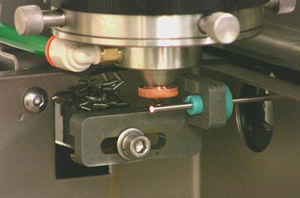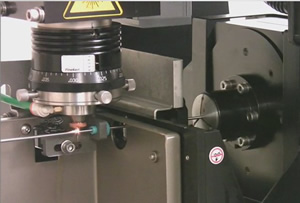Laser Cutting Process
The laser cutting process has undergone significant changes with the advent of the fiber laser power supply, but the overall process remains the same. Laser energy is focused down to a small spot size (less than .001 inch) through the opening in a high-flow gas nozzle (see figure below).
As the laser energy melts the tube wall, argon or oxygen assist gas ejects the melted material from the lased area, creating a precise "slot" with relatively smooth walls. At NLE, the typical slot or "kerf" size is 0.001 or less, making very precise features possible. In some cases (especially when using smaller tubing diameters) water is pumped through the tube during the cutting process, keeping the heat affected zone to a minimum and preventing ejected material from adhering to the opposite inner wall of the tube.
Most standard laser tube cutting systems employ a two axis of motion system. By the use of "feed" and rotation, almost any typical feature (as well as precise cut-off) can be cut into the tube wall (see figure below).
This type of system is relatively fast, accurate and applicable to the majority of tube cutting applications. The only compromise with a two axis system is that all cuts are performed with the axis of the laser beam always pointed directly at the centerline of the tube. As a result, any features cut into the tube will have a tapered wall on all cuts that are not circumferential. It is generally accepted that features will be measured at the inner diameter of the tube, since they will always be slightly smaller than at the outer diameter.
By adding a third (perpendicular to the tube axis) and fourth axis (z-stage of the cutting head), it becomes possible to cut "off-axis" of the tube, maintaining dimensional accuracy throughout the entire tube wall, and enabling the incorporation of more complex geometric features. Four axis cutting can be somewhat more time consuming (and costly), so it is normally utilized only when necessary.
Since NLE has both two and four axis cutting capability, you can be assured that the correct process can be specified for your application. Please give us a call or send us a drawing for a representative quote to see how Northeast Laser & Electropolish can be your one-stop source for all your laser processing and metal finishing needs.








